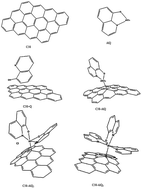A cyclic voltammetry and PM6 semi-empirical molecular orbital method study of the capacity behaviour of an aluminum-8-hydroxyquinoline complex modified carbon paste electrode
Abstract
A graphite powder surface was modified by aluminum-8-hydroxyquinoline complex, and functionalised as an electron storage and transfer surface for use as one of the electrodes in an electrochemical capacitor. The electrochemical capacity behaviour of the aluminum-8-hydroxyquinoline complex modified graphite paste electrode was investigated by cyclic voltammetry experimentally and PM6 semi-empirical molecular method in MOPAC2012 software based on a theoretical model of molecular clusters. The electron-acceptor property of the 8-hydroxyquinoline-aluminum complexes improved the electrochemical capacitor performance, and resulted in a linear relation of catalytic current proportional to scan rate up to 40 V s−1, and the capacity current increases with number of scan cycles up to 17 000 cycles. Quantum chemistry calculation was based on molecular clusters composed of a piece of graphene with 38 carbon atoms and aluminum-8-hydroxyquinoline complex modifiers. The results indicate the modifications are spontaneous processes and are stable in the molecular clusters, which offers suitable LUMOs for charged electrons to be stored in, and are isolated from the π-molecular orbital sea from the graphene and parallel modifiers. Among the three aluminum-8-hydroxyquinoline complexes, the tri-8-hydroxyquinoline-aluminum complex was found to be a better modifier compared with the mono- and bi-8-hydroxyquinoline-aluminum complexes. The results accord well with the experimental data. The stable electronic properties and stability of the modifier are responsible for the good capacitor performance. These results offer a new way for quantum chemical study on electrochemical capacitor and energy storage techniques.



 Please wait while we load your content...
Please wait while we load your content...